各国民族服装英文介绍
- 格式:ppt
- 大小:5.45 MB
- 文档页数:33
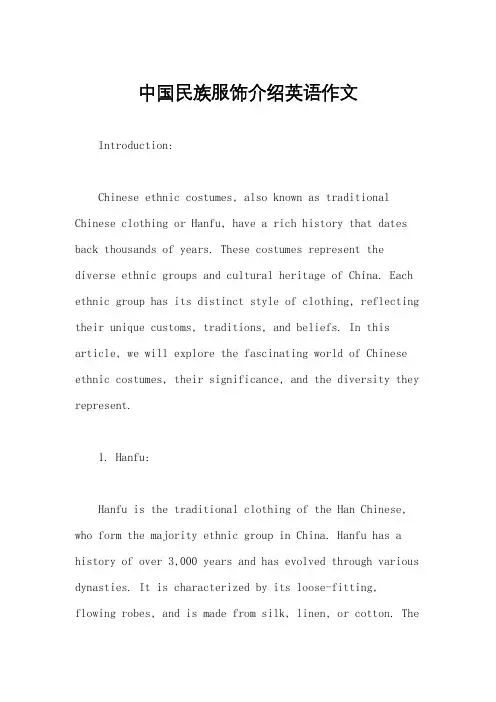
中国民族服饰介绍英语作文Introduction:Chinese ethnic costumes, also known as traditional Chinese clothing or Hanfu, have a rich history that dates back thousands of years. These costumes represent the diverse ethnic groups and cultural heritage of China. Each ethnic group has its distinct style of clothing, reflecting their unique customs, traditions, and beliefs. In this article, we will explore the fascinating world of Chinese ethnic costumes, their significance, and the diversity they represent.1. Hanfu:Hanfu is the traditional clothing of the Han Chinese, who form the majority ethnic group in China. Hanfu has a history of over 3,000 years and has evolved through various dynasties. It is characterized by its loose-fitting, flowing robes, and is made from silk, linen, or cotton. Thestyle and design of Hanfu vary depending on the gender, social status, and occasion.For men, Hanfu typically consists of a robe, a long skirt, and a sash. The robe is often adorned with intricate embroidery and exquisite patterns. Women's Hanfu, on the other hand, includes a long, flowing dress called a Ruqun, which consists of an upper garment and a skirt. The Ruqun can be further embellished with accessories such as a waistband, a shawl, and a headdress.Hanfu represents the elegance, grace, and modesty of ancient Chinese culture. It is often worn duringtraditional festivals, weddings, and other formal occasions to showcase the wearer's respect for tradition and their cultural identity.2. Tibetan Costume:Tibetan costumes are unique and distinct, reflecting the rich cultural heritage of the Tibetan people. The traditional Tibetan costume for men is called a "Chuba." Itis a loose, long-sleeved robe made of wool or silk. The Chuba is often adorned with colorful patterns and intricate designs. Men also wear a waistband and a hat called a "Tsepa" to complete their traditional attire.Women's traditional Tibetan costume is called a "Chuba" as well, but it is more elaborate and vibrant compared to men's. It consists of a long, flowing dress with a widebelt around the waist. The dress is often made of silk and is adorned with intricate embroidery, vibrant colors, and traditional Tibetan motifs. Women also wear various accessories like jewelry, headdresses, and aprons to enhance their traditional look.Tibetan costumes are not only worn on special occasions but are also a part of daily life. They represent the Tibetan people's strong connection to their culture, religion, and natural surroundings.3. Uygur Costume:Uygur costumes are an integral part of the Uygur ethnicgroup's cultural identity in China. The Uygur people, who primarily reside in the Xinjiang Uygur Autonomous Region, have a unique and diverse clothing style influenced bytheir nomadic heritage and Islamic traditions.Uygur men traditionally wear long, loose-fitting robes made of silk or cotton. The robe is often paired with loose trousers and a hat. The colors and patterns of their clothing represent their cultural and religious beliefs. Uygur women wear vibrant, long-sleeved dresses called "Atlas" or "Kemis." These dresses are made of silk and are adorned with intricate embroidery and vibrant patterns. Women also wear a headdress, usually made of silk, which is decorated with beads, feathers, and other ornaments.Uygur costumes are not only visually appealing but also reflect the Uygur people's history, lifestyle, andreligious practices. They are often worn during festivals, weddings, and other celebrations to showcase their cultural pride and identity.4. Zhuang Costume:The Zhuang ethnic group, one of the largest minority groups in China, has its unique traditional costumes that reflect their rich cultural heritage. Zhuang costumes are known for their vibrant colors, intricate embroidery, and exquisite craftsmanship.Zhuang men traditionally wear a collarless jacket, loose trousers, and a headscarf. The jacket is often made of silk or cotton and is adorned with colorful embroidery. Women's traditional Zhuang costume, known as "Luozhuang," is even more elaborate. It consists of a jacket, a long skirt, and an apron. The jacket and skirt are often made of silk and are embellished with intricate embroidery, silver ornaments, and colorful ribbons.Zhuang costumes are not only worn on special occasions but are also a part of the Zhuang people's daily life. They represent their cultural pride, social status, and their connection to their ancestors and nature.Conclusion:Chinese ethnic costumes, with their diverse styles, designs, and cultural significance, are a testament to the rich heritage and diversity of China's ethnic groups. Each costume represents a unique blend of history, tradition, and cultural identity. Whether it's the elegant Hanfu, the vibrant Tibetan costume, the Islamic-influenced Uygur costume, or the intricate Zhuang costume, these traditional attires showcase the beauty and cultural pride of the Chinese people. Preserving and promoting these costumes is crucial in maintaining the cultural diversity and heritage of China.。
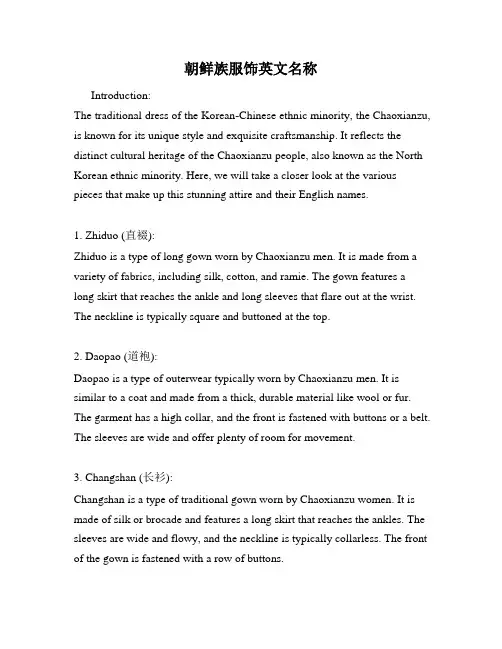
朝鲜族服饰英文名称Introduction:The traditional dress of the Korean-Chinese ethnic minority, the Chaoxianzu, is known for its unique style and exquisite craftsmanship. It reflects the distinct cultural heritage of the Chaoxianzu people, also known as the North Korean ethnic minority. Here, we will take a closer look at the various pieces that make up this stunning attire and their English names.1. Zhiduo (直裰):Zhiduo is a type of long gown worn by Chaoxianzu men. It is made from a variety of fabrics, including silk, cotton, and ramie. The gown features a long skirt that reaches the ankle and long sleeves that flare out at the wrist. The neckline is typically square and buttoned at the top.2. Daopao (道袍):Daopao is a type of outerwear typically worn by Chaoxianzu men. It is similar to a coat and made from a thick, durable material like wool or fur. The garment has a high collar, and the front is fastened with buttons or a belt. The sleeves are wide and offer plenty of room for movement.3. Changshan (长衫):Changshan is a type of traditional gown worn by Chaoxianzu women. It is made of silk or brocade and features a long skirt that reaches the ankles. The sleeves are wide and flowy, and the neckline is typically collarless. The front of the gown is fastened with a row of buttons.4. Danshan (单衫):Danshan is a type of long top worn by Chaoxianzu women. It is typically made of silk, and the garment features a high collar and long sleeves. It is worn over a long skirt and has a slim, form-fitting silhouette.5. Qipao (旗袍):Qipao is a type of close-fitting dress that originated in China but is also worn by Chaoxianzu women. It is made of a lightweight material like silk or cotton and features a high collar and long sleeves. The dress has a slim silhouette that accentuates the curves of the wearer.Conclusion:The traditional dress of the Chaoxianzu people is a beautiful and elaborate attire that reflects the cultural heritage of this ethnic minority. From the long gowns worn by men to the flowing dresses worn by women, each piece has a unique style and craftsmanship that sets it apart. We hope this guide has given you a better understanding of these garments and their English names.。
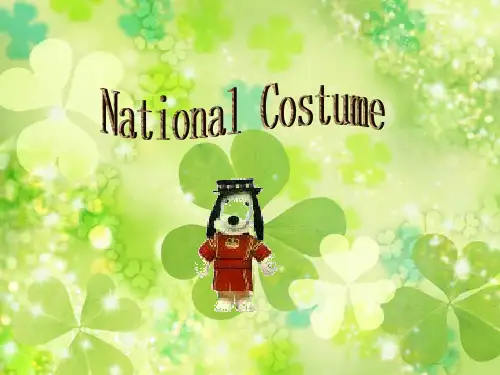
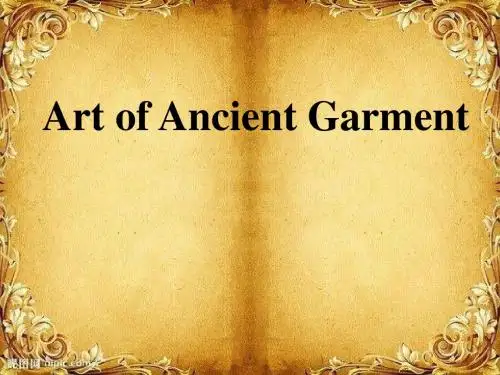
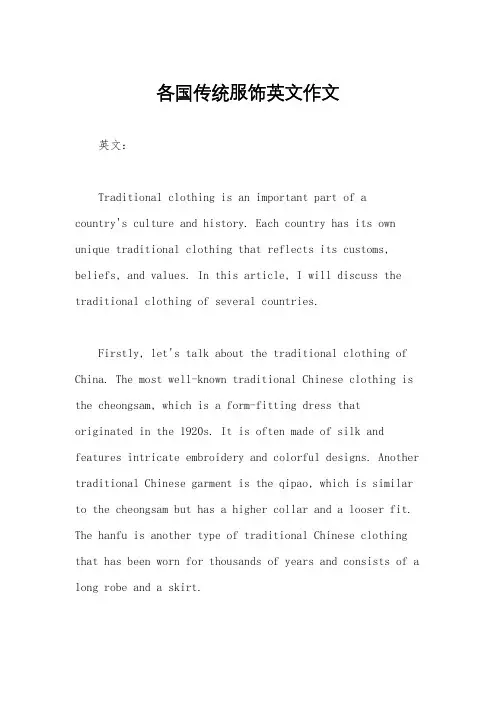
各国传统服饰英文作文英文:Traditional clothing is an important part of acountry's culture and history. Each country has its own unique traditional clothing that reflects its customs, beliefs, and values. In this article, I will discuss the traditional clothing of several countries.Firstly, let's talk about the traditional clothing of China. The most well-known traditional Chinese clothing is the cheongsam, which is a form-fitting dress thatoriginated in the 1920s. It is often made of silk and features intricate embroidery and colorful designs. Another traditional Chinese garment is the qipao, which is similar to the cheongsam but has a higher collar and a looser fit. The hanfu is another type of traditional Chinese clothing that has been worn for thousands of years and consists of a long robe and a skirt.Next, let's look at the traditional clothing of Japan. The kimono is the most iconic piece of traditional Japanese clothing. It is a long, flowing robe that is often made of silk and features elaborate designs and patterns. The yukata is a lighter and more casual version of the kimono that is worn in the summer. Another traditional Japanese garment is the hakama, which is a type of wide-legged pants that were originally worn by samurai.Moving on to India, the traditional clothing is incredibly diverse and varies depending on the region and occasion. The saree is perhaps the most well-known traditional Indian garment. It is a long piece of fabric that is draped around the body and can be worn in many different styles. The salwar kameez is another popular traditional Indian outfit that consists of a long tunic and loose pants. The dhoti is a type of garment that is worn by men and consists of a long piece of cloth that is wrapped around the waist.In Africa, traditional clothing also varies greatly depending on the region and culture. The dashiki is a typeof shirt that is commonly worn in West Africa. It is often made of bright, colorful fabric and features intricate patterns. The kaftan is another traditional African garment that is worn by both men and women. It is a long, loose-fitting robe that is often made of cotton or silk.In conclusion, traditional clothing is an importantpart of a country's culture and history. Each country hasits own unique traditional clothing that reflects its customs, beliefs, and values. By wearing traditional clothing, people can connect with their cultural heritage and celebrate their identity.中文:传统服饰是一个国家文化和历史的重要组成部分。
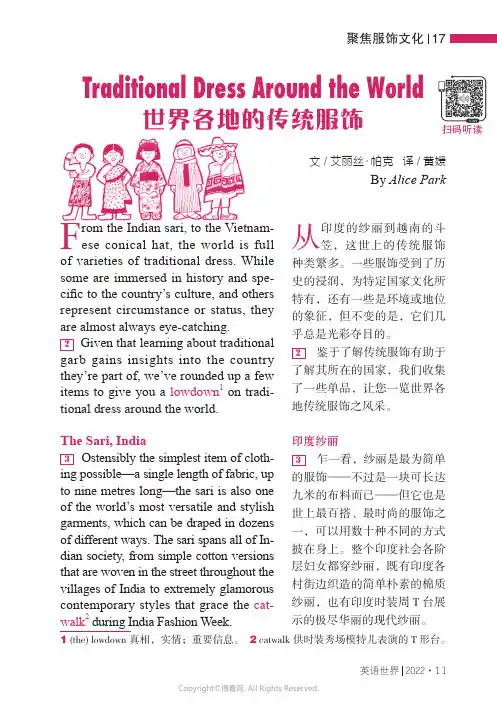
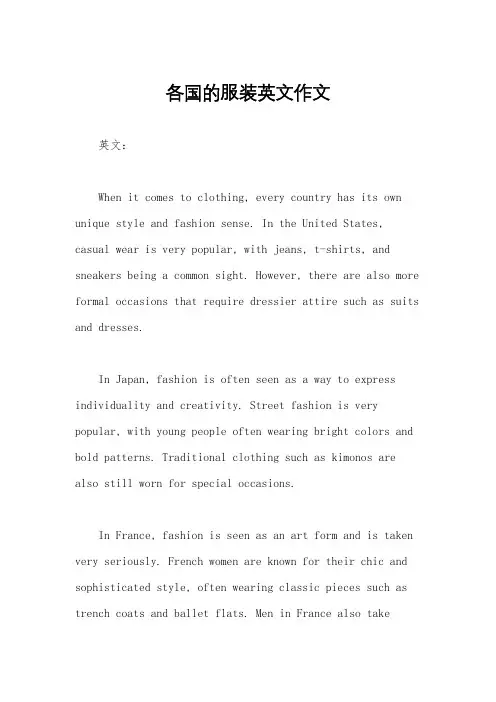
各国的服装英文作文英文:When it comes to clothing, every country has its own unique style and fashion sense. In the United States, casual wear is very popular, with jeans, t-shirts, and sneakers being a common sight. However, there are also more formal occasions that require dressier attire such as suits and dresses.In Japan, fashion is often seen as a way to express individuality and creativity. Street fashion is very popular, with young people often wearing bright colors and bold patterns. Traditional clothing such as kimonos are also still worn for special occasions.In France, fashion is seen as an art form and is taken very seriously. French women are known for their chic and sophisticated style, often wearing classic pieces such as trench coats and ballet flats. Men in France also takepride in their appearance, often wearing well-tailored suits.In China, traditional clothing such as the qipao and hanfu are still worn for special occasions, but Western fashion has also become popular in recent years. Young people often follow the latest trends, with streetwear and sportswear being popular choices.中文:说到服装,每个国家都有自己独特的风格和时尚感。
![各国传统服装英文[1]](https://uimg.taocdn.com/a5368655102de2bd960588b8.webp)

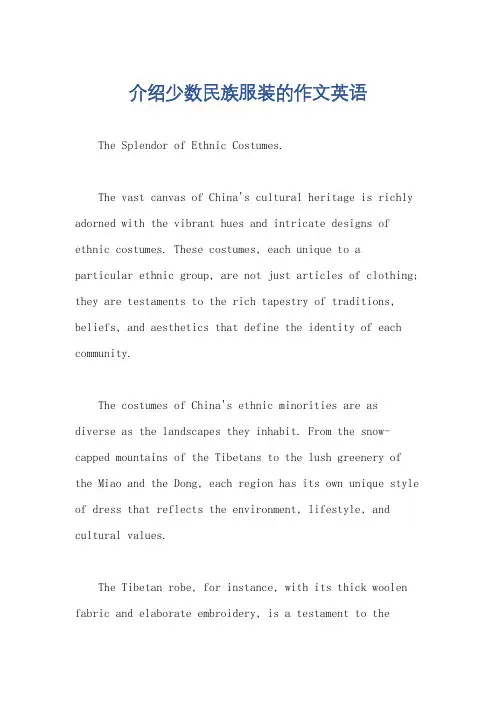
介绍少数民族服装的作文英语The Splendor of Ethnic Costumes.The vast canvas of China's cultural heritage is richly adorned with the vibrant hues and intricate designs of ethnic costumes. These costumes, each unique to aparticular ethnic group, are not just articles of clothing; they are testaments to the rich tapestry of traditions, beliefs, and aesthetics that define the identity of each community.The costumes of China's ethnic minorities are as diverse as the landscapes they inhabit. From the snow-capped mountains of the Tibetans to the lush greenery of the Miao and the Dong, each region has its own unique style of dress that reflects the environment, lifestyle, and cultural values.The Tibetan robe, for instance, with its thick woolen fabric and elaborate embroidery, is a testament to theharsh climes of the Himalayas. The vibrant blues and redsof the robe not only keep the wearer warm but also serve as a symbol of their strong spiritual beliefs. Similarly, the Hui's traditional long coats and hats, with their Islamic influence, exude a sense of modesty and piety.The Miao and Dong women, known for their intricatesilver jewelry and brightly colored dresses, wear costumes that are as elaborate as they are functional. The intricate patterns and designs on their dresses are often passed down through generations, serving as a form of oral history anda testament to their rich cultural heritage.The costumes of the Mongolians, with their distinctive fur trim and wide sleeves, reflect the nomadic lifestyle of this ethnic group. Their clothing is designed to withstand the rigors of the steppe, while also serving as a symbol of their proud warrior heritage.The Uyghurs, with their distinctive hats and long, flowing robes, exude a sense of elegance and sophistication. Their costumes, often made from silk and other luxuriousfabrics, are a testament to their rich cultural heritage and their status as traders and merchants on the Silk Road.The influence of these ethnic costumes can be seen in various aspects of Chinese culture, from art and music to dance and theater. The vibrant colors and intricate designs of these costumes have also influenced fashion trends in modern China, with many designers incorporating ethnic elements into their collections.In conclusion, the costumes of China's ethnicminorities are not just articles of clothing; they are cultural icons that represent the rich diversity and unique identity of each ethnic group. They are a testament to the resilience and adaptability of these communities, who have preserved their traditions and values through the ages. As we celebrate the beauty and splendor of these costumes, we also pay tribute to the hardworking craftsmen and women who have spent generations perfecting their skills and keeping these traditions alive.。

介绍一个民族服装作文英文英文:When it comes to traditional clothing, one of the most fascinating aspects of different cultures is the variety of ethnic clothing. Today, I would like to introduce the traditional clothing of the Han Chinese, which is known for its rich history and beautiful designs.The traditional clothing of the Han Chinese, also known as Hanfu, has a history of over 3,000 years. It is characterized by its elegant and flowing lines, with loose and comfortable fitting. The Hanfu is often made of silk, which is a symbol of the high status and elegance of the wearer. The designs of Hanfu vary depending on the occasion and the social status of the wearer. For example, the clothing for everyday wear is simpler and more practical, while the clothing for special occasions, such as weddings or ceremonies, is more elaborate and ornate.One of the most iconic pieces of Hanfu is the "Ruqun", which is a two-piece garment consisting of a top and a skirt. The top is usually a cross-collar robe with wide sleeves, while the skirt is long and flowing. The Ruqun is often worn with a sash or a ribbon tied around the waist, which adds a touch of elegance to the outfit.In addition to the Ruqun, there are many other styles of Hanfu, each with its own unique features and significance. For example, the "Shenyi" is a unisex style of Hanfu that consists of a cross-collar robe and a long skirt, which is often worn by scholars and intellectuals. The "Qixiong Ruqun" is a style of Hanfu with a tight-fitting top and a pleated skirt, which is commonly worn by women of high social status.The Hanfu is not only a symbol of tradition andcultural heritage, but also a form of self-expression and identity. Many young people today are rediscovering the beauty and elegance of Hanfu, and there is a growing movement to revive the tradition of wearing Hanfu in modern society.中文:说到传统服饰,不同文化的最迷人之处之一就是多样的民族服装。
介绍少数民族服装英语作文English:Minority ethnic groups in China have a rich and diverse culture when it comes to clothing. Each ethnic group has its own unique traditional costumes that reflect their beliefs, history, and lifestyle. For example, the Miao people in Guizhou Province are known for their intricate silver ornaments and colorful embroidered clothes. The Tibetan people wear long robes with beautiful patterns and intricate designs that are both functional and symbolic. The Uyghur people in Xinjiang have a distinctive style of dress that includes vibrant colors, delicate embroidery, and intricate patterns. These traditional costumes not only serve as a way for minority groups to express their cultural identity but also act as a way to preserve and pass down their heritage to future generations.Translated content:中国的少数民族拥有丰富多样的服装文化。
如何介绍蒙古服饰英语作文The rich tapestry of Mongolian culture is reflected in its vibrant and unique clothing, which serves not only as a form of attire but also as a medium for expressing cultural identity and heritage. The traditional Mongolian costume, known as "delger," encapsulates the essence of this ancient civilization, combining comfort, functionality, andartistic expression.The foundation of Mongolian clothing is the deel, a long, robe-like garment that covers the body from the neckto the ankles. Typically made from sheep's wool or cashmere, the deel is warm and insulating, essential for survivingthe harsh winters of the Mongolian plateau. Its design is both practical and stylish, with a loose fit that allowsfor freedom of movement and a belt that cinches the waist, creating a tailored look.The deel is often accessorized with a variety of garments and accessories that further enhance its aesthetic appeal. The most distinctive among these is the tsagaan chovool, or "white cap," a felt hat with a rounded crownand a rim that shades the face from the sun. The hat isusually adorned with intricate embroidery or decorative trim, reflecting the meticulous craftsmanship of Mongolian artisans.Another notable accessory is the gobi, a long, rectangular scarf that is wrapped around the neck and shoulders. The gobi is not only a decorative element but also serves to protect the wearer from dust and wind. It is often made from brightly colored fabrics, adding a vibrant splash of color to the otherwise monochromatic palette of Mongolian clothing.The Mongolian costume also includes boots, typically made from sheepskin or cowhide, which are sturdy and well-suited for the rugged terrain. These boots, known as "yurts," are another example of the blend of comfort and style in Mongolian clothing.The beauty of Mongolian clothing lies not just in its practicality and durability but also in its intricate designs and vibrant colors. Embroidery and ornamentation are a central part of Mongolian clothing, with patterns often featuring motifs such as flowers, animals, and geometric shapes. These designs are not just aestheticallypleasing but also carry deep cultural significance, representing various aspects of Mongolian life and history. The use of bright colors is another hallmark of Mongolian clothing. Red, blue, and gold are particularly popular colors, often used to decorate the edges of garments or to embellish accessories. These colors not only stand out against the stark natural landscape of Mongolia but also symbolize good luck, prosperity, and respect.In conclusion, Mongolian clothing is a remarkable testament to the rich cultural heritage and artistic prowess of this ancient civilization. It is a blend of tradition and aesthetics, reflecting not just the practical needs of the people but also their deep connection to their land and culture. The delicate embroidery, vibrant colors, and meticulous craftsmanship of Mongolian clothing are a celebration of this unique cultural identity, making it a fascinating and fascinating aspect of Mongolian life.**介绍蒙古服饰:传统与美学的融合**蒙古文化的丰富画卷在其生动独特的服饰中得到了体现,这种服饰不仅是一种着装形式,还是表达文化认同和遗产的媒介。
维吾尔族服饰英文简介一、维吾尔族服饰英文简介Uyghur traditional costumes are an integral part of the culture of Xinjiang Uyghurs. With strong ethnic characteristics, the traditional male attire mainly consists of robes, waistcoats, and trousers, while the female attire includes robes, skirts, and trousers. The colors of Uyghur costumes are bright, and the embroidery work is exquisite, with diverse accessories, showcasing unique ethnic style. In addition, the materials used for Uyghur costumes are diverse, mainly consisting of natural fibers such as cotton, wool, silk, and hemp, with a focus on texture and comfort.The unique style and color matching are the characteristics of Uyghur costumes. The male robes are usually dark colors such as black, gray, and dark blue, which highlight the dignified and introverted personalitycharacteristics. Female robes are mainly bright colors such as red, green, and yellow, matched with bright headwear and accessories, showcasing the enthusiasm and liveliness of women. In addition, the embroidery work of Uyghur costumes is also unique, with themes such as flowers, animals, and characters, symbolizing good fortune and beauty.In summary, Uyghur costumes are an important part of Xinjiang Uyghur culture, with strong ethnic characteristics and unique artistic value.二、维吾尔族服饰中文简介维吾尔族服饰是新疆维吾尔族传统服装,具有浓郁的民族特色。
介绍少数民族服装的作文英语The Vibrant Diversity of Ethnic Clothing in ChinaChina, a vast and diverse country, is renowned for its rich cultural heritage. One such aspect that strikingly illustrates this diversity is the vibrant and colorful ethnic clothing of its various minority groups. These ethnicities, scattered across the length and breadth of the country, have maintained their unique cultural identities through their traditional attire, which often serves as a testament to their rich historical backgrounds and way of life.Each ethnic group in China boasts a distinct style of clothing, often adorned with intricate patterns and vibrant hues. These garments are not mere outfits; they are symbols of pride, heritage, and tradition. For instance, the Miao ethnic group of Guizhou and Hunan provinces is known for their intricately embroidered costumes, often featuring images of flowers, birds, and mythical creatures. Similarly, the Tibetan people of the snow-capped Himalayas wear robes made of sheep's wool, adorned with silver jewelry and elaborate patterns, reflecting their adaptation to the harsh climate.The materials used in these ethnic costumes also vary depending on the region and climate. Cotton, silk, and wool are commonly used, with each material chosen for its adaptability to the specific environmental conditions. The skills and techniques employed in creating these garments are often passed down from generation to generation, making them a testament to the continuity of cultural practices.The ethnic clothing of China not only represents the diversity within the country but also serves as a bridge connecting the past with the present. It provides a window into the lives and traditions of these minority groups, allowing us to appreciate the rich tapestry of Chinese culture. In today's globalized world, where cultural homogenization is a growing concern, it is crucial to cherish and preserve such unique expressions of identity.In conclusion, the ethnic clothing of China is a vibrant display of the country's diverse cultural landscape. It is a powerful reminder of the rich historical backgrounds and traditions of its minority groups, serving as a symbol of pride and heritage. As we move forward in the 21st century, it is imperative to uphold these traditional values and ensure that they are passed down to future generations, allowing the beauty and uniqueness of Chinese ethnic clothing to thrive and flourish.。